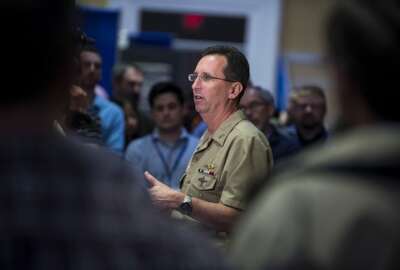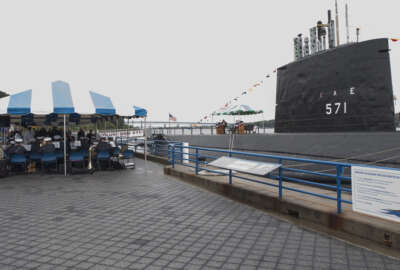
Naval Supply Systems Command realign for readiness, lethality
For Naval Supply Systems Command (NAVSUP), emphasizing readiness and lethality means making sure Navy maintainers have the parts they need, when they need them.
When Defense Secretary Jim Mattis’ National Defense Strategy emphasized readiness and lethality, that triggered transformation efforts through the Navy Department. For Naval Supply Systems Command (NAVSUP), that means making sure Navy maintainers have the parts they need, when they need them.
“If you’ve got a clear outcome you’re trying to achieve, that gives you a clear target to shoot at. And then it’s about that alignment to those objectives,” Michael Madden, NAVSUP’s vice commander, said on Agency in Focus: Navy. “If you look at what NAVSUP does, we buy spares for ships, airplanes and submarines. When you do that, we’re buying in anticipation of need. So I like to use the term ‘we buy lead time.’”
For NAVSUP, time is the big element. It needs inventory to cover time. If it can use less time, compact it, it can make smaller investments in inventory. So NAVSUP is examining its processes, seeing where it can cut time that doesn’t add value, like when contractors don’t have a complete understanding of the requirement.
But years of continuing resolutions and the Budget Control Act have made that harder. Processes that helped NAVSUP adjust to that have resulted in suboptimization, and that’s difficult to track down and root out.
“Is there something embedded in our processes that was there to handle the lower funding levels that we need to rethink?” Madden said. “It’s not about not being efficient; what you’re really trying to figure out is what is the effectiveness that I’m trying to achieve, at the same time being good stewards of public funds.”
So NAVSUP is looking to the commercial world to understand how industrial providers of raw material like General Electric or Caterpillar provide support.
That’s lead to NAVSUP deploying its people more strategically than in the past. For example, it now has more people in the field.
“So we’re going into the shipyards, we’re going into the aviation depots, to make sure that we really understand what’s going on on the ground so that we’re not missing anything when we start forecasting leads in the future,” Madden said. “If you think about it, shipyards and aviation depots, those are readiness generators. … If you are not in those locations, you are missing that opportunity to help drive that outcome.”
That’s giving NAVSUP better insights into operations and special events that can drive requirements. For example, if routine maintenance involves servicing 20 aircraft, but there’s a new plan to go to 40, the command needs to anticipate the need for more materials.
“What you’re trying to do is understand the environment so that you can understand what’s forecastable,” Madden said. “For the most part, the customer sees the supply process as a black box. ‘Just get me my stuff,’ that’s the way they view it. What they need is that executive agent, the translator of that system, so that in the occasion where you have that exception … you need a supply officer to be engaged at that level so they can work those exceptions inside that black box to make sure that there’s a good outcome for that customer.”
Copyright © 2024 Federal News Network. All rights reserved. This website is not intended for users located within the European Economic Area.
Daisy Thornton is Federal News Network’s digital managing editor. In addition to her editing responsibilities, she covers federal management, workforce and technology issues. She is also the commentary editor; email her your letters to the editor and pitches for contributed bylines.
Follow @dthorntonWFED





